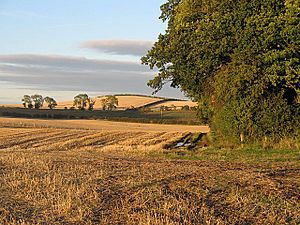Crop rotation facts for kids
Crop rotation is a smart farming technique where farmers plant different crops in a specific order on the same land, season after season. This practice has been around for thousands of years, with evidence suggesting that farmers in the Middle East were using it as early as 6000 BC.
Contents
Why is crop rotation important?
Imagine eating only one type of food every day. You might start to feel tired and weak because you're not getting all the nutrients your body needs. The same thing can happen to soil if farmers plant the same crop in the same place year after year.
- Soil Health: Different crops need different nutrients from the soil. Some crops, like corn, take a lot of nitrogen. Others, like beans, can put nitrogen back into the soil. By rotating crops, farmers can keep the soil balanced and healthy.
- Pest and disease control: Pests and diseases often target specific plants. If a farmer plants the same crop in the same field every year, these pests and diseases can build up in the soil and cause big problems. But by rotating crops, farmers can disrupt the life cycles of these pests and diseases, making it harder for them to survive.
- Weed management: Weeds can also be a problem for farmers. Some crops are better at competing with weeds than others. By rotating crops, farmers can use different strategies to control weeds and keep them from taking over their fields.
- Reducing soil erosion: Rotating crops helps to improve soil stability by alternating between crops with deep roots and those with shallow roots.
History
Crop rotation isn't a new idea. Farmers have been using it for thousands of years to keep their soil healthy and their crops growing strong.
- Farmers in the Middle East were practicing crop rotation as far back as 6000 BC. They knew that planting different crops in a sequence helped their fields stay productive.
- The Romans also used crop rotation. They would plant legumes (like beans and peas) one season and grains (like wheat and barley) the next. Legumes help to put nitrogen back into the soil, which is important for growing healthy grains.
- In Europe, farmers used a three-field system. They divided their land into three parts. One part would be planted with winter wheat or rye, the second part with spring oats or barley, and the third part would be left fallow (unplanted) to rest. Each year, they would rotate the crops so that each field got a chance to rest and recover.
- In the 17th and 18th centuries, new crop rotation methods were developed that helped to increase food production. One famous example is the Norfolk four-course system, which involved planting wheat, turnips, barley, and clover in a specific order. This system helped to improve soil fertility and allowed farmers to raise more livestock.
Examples
There are many different ways to rotate crops, depending on the climate, soil type, and the crops that a farmer wants to grow. Here are a few examples:
- Two-Year rotation: A simple rotation might involve planting corn one year and soybeans the next. Corn takes a lot of nitrogen from the soil, while soybeans put nitrogen back in.
- Three-Year rotation: A three-year rotation could involve planting wheat, then corn, then soybeans.
- Four-Year rotation: A four-year rotation might include planting potatoes, oats, peas, and rye.
- Vegetable garden rotation: In a vegetable garden, you could rotate between different plant families. For example, you might plant beans (Leguminoseae family) one year, then tomatoes (Solanaceae family) the next, and then sweet corn (Poaceae family) the following year.
Benefits
Crop rotation has many benefits for farmers and the environment.
- It helps to improve soil structure, increase organic matter, and balance nutrients. This leads to healthier soil that can hold more water and support strong plant growth.
- By rotating crops, farmers can reduce their need for synthetic fertilizers. This is because some crops, like legumes, can naturally add nutrients to the soil.
- Crop rotation can help to reduce soil erosion by alternating between crops with different root systems. Deep-rooted crops can help to hold the soil in place, while shallow-rooted crops can provide a protective cover.
- The practice enables farmers to control pests and diseases by disrupting their life cycles. When farmers change the crops they plant, it makes it harder for pests and diseases to find a host and survive.
- It provides a variety of habitats for different plants and animals, thus increasing biodiversity on farms.
- Studies have shown that crops grown in rotation often have higher yields than crops grown in the same place every year.
Challenges
While crop rotation has many benefits, it can also be challenging for farmers.
- Crop rotation requires careful planning to make sure that the right crops are planted in the right order.
- Farmers need to consider market prices when deciding which crops to plant. If the price of a particular crop is low, they may not want to include it in their rotation.
- Different crops may require different equipment for planting and harvesting.
- Farmers need to have knowledge about different crops and how they affect the soil.
Images for kids
-
Effects of crop rotation and monoculture at the Swojec Experimental Farm, Wrocław University of Environmental and Life Sciences. In the front field, the "Norfolk" crop rotation sequence (potatoes, oats, peas, rye) is being applied; in the back field, rye has been grown for 58 years in a row.
See also
 In Spanish: Rotación de cultivos para niños
In Spanish: Rotación de cultivos para niños




